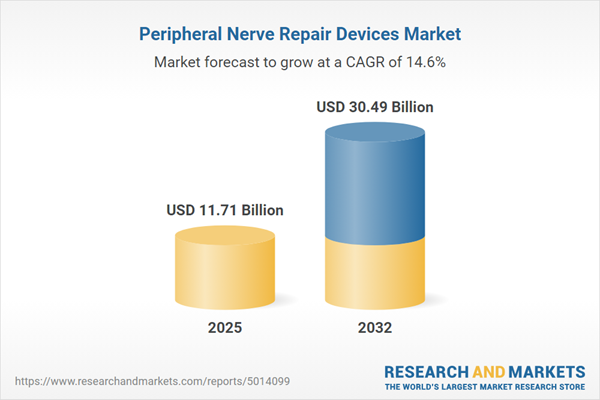Speak directly to the analyst to clarify any post sales queries you may have.
The peripheral nerve repair devices market holds increasing strategic importance for senior decision-makers in healthcare, bringing opportunities for improved clinical outcomes, operational resilience, and leadership in advanced neurological and trauma care innovation.
Market Snapshot: Peripheral Nerve Repair Devices Market Growth and Outlook
The peripheral nerve repair devices market shows robust and sustained global expansion, now valued at USD 10.24 billion and forecast to reach USD 30.49 billion by 2032 with a compound annual growth rate (CAGR) of 14.61%. This momentum is fueled by increasing global demand for sophisticated nerve repair solutions and the progressive integration of devices into trauma and reconstructive care. Ongoing advancements in device technology, from engineering breakthroughs to expanded clinical utility, are reshaping care pathways across diverse health systems. As organizations seek to optimize both clinical and operational performance, the market’s appeal to forward-thinking investors and senior leaders continues to accelerate.
Scope & Segmentation: Strategic Perspective for Senior Executives
This report equips executive teams with actionable intelligence for strategic investments and resource optimization within the peripheral nerve repair devices landscape. The following segmented areas provide a clear roadmap for considered decision-making and long-term business planning:
- Product Types: Includes nerve conduits, nerve grafts, nerve wraps, and neurotrophic factors. Each addresses distinct challenges found in trauma and reconstructive care, encouraging adaptation across both acute and post-acute treatment scenarios.
- Graft Categories: Highlights the application of allografts, autografts, and xenografts. These allow organizations to align with varied institutional protocols and regulatory requirements, providing options suitable for different patient populations and operational needs.
- Technologies: Incorporates biodegradable polymers, synthetic materials, collagen, and extracellular matrices. This diversity in material base supports compatibility with new and established surgical workflows, driving clinical adaptability and readiness for technology upgrades.
- Repair Sites: Focuses on devices tailored for cranial, upper extremity, and lower extremity procedures. These feature specialized designs that meet the distinct requirements of complex surgical interventions.
- Procedure Types: Encompasses endoscopic, microsurgical, and robotic-assisted techniques that emphasize workflow precision and support sophisticated surgical management.
- Applications: Spans chronic neurological management, acute trauma response, and post-surgical rehabilitation. Solutions in this segment bolster comprehensive care in clinical and research contexts alike.
- End Users: Addresses the inclusion of hospitals, ambulatory surgical centers, and research institutions that integrate these devices to boost organizational capacity, quality of care, and readiness for technological advances.
- Regional Coverage: Analyzes key global growth zones, notably the Americas, Europe, Middle East, Africa, and Asia-Pacific, with market influence concentrated in the United States, China, Japan, and Germany.
- Company Profiles: Offers in-depth examinations of principal organizations such as AxoGen Corporation, Integra LifeSciences Holdings, Stryker Corporation, and Baxter International, sharing strategy benchmarks and collaboration insights.
Key Takeaways for Senior Decision-Makers
- Continual advances in biomaterials and device engineering are broadening intervention possibilities, deepening the management of complex nerve injuries, and powering more precise care pathways.
- Customizable product selection empowers clinical teams to match devices and approaches to patient profiles, enhancing both care quality and overall organizational objectives.
- Major healthcare networks are early adopters of advanced technologies, but accelerating investments in workforce training and infrastructure extend competitive momentum in developing markets.
- Strategic collaborations and alliances remain essential, allowing organizations to strengthen expertise, adapt to regulatory evolution, and broaden technical capabilities in the nerve repair sector.
- Resilient procurement initiatives and proactive supply chain strategies are critical for maintaining continuous device availability, mitigating compliance risk, and responding to shifting global supply environments.
Tariff Impact on Supply Chain Resilience
Potential tariffs on key device inputs, such as polymers and biologics in the United States, require healthcare organizations to reassess procurement strategies. Collaborative and flexible sourcing arrangements build supply chain resilience, help maintain regulatory compliance, and support continuity through evolving policy landscapes.
Methodology & Data Sources
This analysis leverages direct interviews with healthcare decision-makers, a systematic review of industry literature, and economic scenario modeling. Combining these sources ensures credible, practical findings tailored for strategic leadership teams.
Why This Report Matters
- Empowers executives with market diversification strategies and proactive responses to regulatory and clinical shifts within the peripheral nerve repair devices sector.
- Supports robust supply chain and procurement decision-making, positioning organizations for sustained performance in dynamic healthcare environments.
- Delivers actionable, evidence-based insights that enable forward-looking planning and technology-driven innovation for ongoing sector leadership.
Conclusion
Focused technology investment, adaptable operational strategies, and strategic collaboration help senior executives fortify organizational leadership and drive sustainable growth within the peripheral nerve repair solutions market.
Additional Product Information:
- Purchase of this report includes 1 year online access with quarterly updates.
- This report can be updated on request. Please contact our Customer Experience team using the Ask a Question widget on our website.
Table of Contents
3. Executive Summary
4. Market Overview
7. Cumulative Impact of Artificial Intelligence 2025
Companies Mentioned
The companies profiled in this Peripheral Nerve Repair Devices market report include:- AxoGen Corporation
- Integra LifeSciences Holdings Corporation
- Stryker Corporation
- Baxter International Inc.
- Johnson & Johnson
- Medtronic PLC
- Terumo Corporation
- Collagen Matrix, Inc.
- Polyganics B.V.
- Tissue Regenix Group PLC
Table Information
| Report Attribute | Details |
|---|---|
| No. of Pages | 194 |
| Published | November 2025 |
| Forecast Period | 2025 - 2032 |
| Estimated Market Value ( USD | $ 11.71 Billion |
| Forecasted Market Value ( USD | $ 30.49 Billion |
| Compound Annual Growth Rate | 14.6% |
| Regions Covered | Global |
| No. of Companies Mentioned | 11 |









